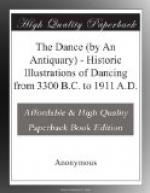At the end of the sixteenth century we get a work on dancing which shows us completely its position as a social art in that day. It is the “Orchesographie” of Thoinot Arbeau (Jean Tabouret, Canon of Langres, in 1588), from which comes the illustration of the “Galliarde” (fig. 49) and to which I would refer the reader for all the information he desires concerning this period. In this work much stress is laid on the value of learning to dance from many points of view—development of strength, manner, habits and courtesy, etc. Alas! we know now that all these external habits can be acquired and leave the “natural man” beneath. [Illustration: Fig. 49.—La Galliarde. From the “Orchesographie” of Thoinot Arbeau (Jean Tabourot), Langres, 1588.]
Desirable, therefore, as good manners and such like are, they do not fulfil all the requirements that the worthy Canon wished to be involved by them.
[Footnote: The advice which he gives is valuable from its bearing on the customs of the 16th century. It even has great historical value, indicating the influence dancing has had on good manners. That the history of dancing is the history of manners may be too much insisted upon. For these reasons we insert these little known passages. The first has reference to the right way of proceeding at a ball.
“Having entered the place where the company is gathered for the dance, choose a good young lady (honneste damoiselle) and raising your hat or bonnet with your right hand you will conduct her to the ball with your left. She, wise and well trained, will tender her left and rise to follow you. Then in the sight of all you conduct her to the end of the room, and you will request the players of instruments to strike up a ‘basse danse’; because otherwise through inadvertance they might strike up some other kind of dance. And when they commence to play you must commence to dance. And be careful, that they understand, in your asking for a ‘basse danse,’ you desire a regular and usual one. Nevertheless, if the air of one song on which the ‘basse danse’ is formed pleases you more than another you can give the beginning of the strain to them.”
“Capriol:—If the lady refuses, I shall feel very ashamed.
“Arbeau:—A
well-trained lady never refuses him who so honours
her as to lead her to the dance.
“Capriol:—I
think so too, but in the meantime the shame of the
refusal remains with me.
“Arbeau:—If you feel sure of another lady’s graciousness, take her and leave aside this graceless one, asking her to excuse you for having been importunate; nevertheless, there are those who would not bear it so patiently. But it is better to speak thus than with bitterness, because in so doing you acquire a reputation for being gentle and humane, and to her will fall the character of a ‘glorieuse’ unworthy of the attention paid her.”




